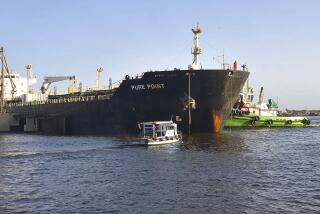Oil Prices Climb Above $30 Barrier
- Share via
Oil surged above $31 a barrel on Wednesday, leapfrogging the $30 price that had stood for years as a psychological barrier between the oil price shocks of the late 1970s and the more recent era of cheap energy.
The latest leap in prices was not driven by any dramatic new events or change in oil supplies but by a continuation of the panicky psychology that has pervaded the oil markets since Iraq invaded Kuwait on Aug. 2, analysts said.
The possibility of a long siege in the Middle East gave oil experts little reason to think that prices will fall any time soon. And they said that even minor disruptions in the movement of oil around the globe could drive prices far higher.
“With the continued possibility of combat, the upside potential is a long way from where prices are today,” said John Redpath, oil analyst at Energy Security Analysis in Washington.
The price of a 42-gallon barrel of West Texas Intermediate crude oil jumped by $2.51 to $31.22, the highest level in nearly five years. The price is that fetched by a contract traded Wednesday on the New York Mercantile Exchange for delivery of crude oil in October.
Futures contracts for gasoline also were up sharply, climbing nearly 3 cents to $1.042 a gallon for unleaded regular. In normal markets, that price would eventually mean $1.50 to $1.60 at the pump, industry spokesmen said, once taxes, transportation and profits are added. Retail prices peaked in 1981 at about $1.45 a gallon, but industry spokesmen pointed out that, adjusted for inflation, that would be about $2 a gallon in 1990 dollars.
Traders blamed Wednesday’s sharp increases on fresh signs of disarray in the Organization of Petroleum Exporting Countries and news that Saudi Arabian oil bound for Japan had been diverted to serve as jet fuel for the U.S. and Saudi military buildup.
Neither event signaled a new assessment of how much oil will be available to meet world demand. In fact, the latest crude oil and gasoline inventory report Tuesday from the American Petroleum Institute was more favorable than expected.
But nervousness in Japan over the diverted oil cargoes drove prices up dramatically in Tokyo, then in London and New York. Traders said that Wednesday’s press conference by President Bush didn’t help, even though there was no major news.
“You add the continuing fears that we could have the destruction of the oil fields in Saudi Arabia, and people just keep buying and buying,” said Peter Beutel, a trader at Merrill Lynch Futures in New York. “Every time Bush gets on TV, it seems like it heightens the tension.”
At $31, crude oil prices have virtually doubled since mid-June.
The $30 barrier is deemed important because it was the rough starting point for a steep collapse that began in November, 1985, and bottomed out six months later at $9 a barrel. Since then, prices have bounced between $14 and $20, far below the levels that ravaged the world economy in the 1970s and early 1980s.
Even Wednesday’s price was moderate compared to the oil-shock years. Adjusted for inflation, the price of oil would have to reach about $35 a barrel to be comparable to the 1985 level. And, to match the peak of $37 reached in 1981, oil today would have to hit about $50 a barrel, Tom Burns, head of the economic staff at Chevron Corp., estimated.
“It still is cheaper” than it was in 1985, Burns said, “but we’re getting close. There wasn’t that much inflation in the last five years.”
One reason that oil traders are so jumpy is that promises by OPEC members Saudi Arabia, Venezuela and the United Arab Emirates to increase oil output--to make up for oil lost from Iraq and Kuwait--remain clouded by uncertainty and OPEC politics.
Analyst Redpath said that, if the 4.2 million barrels of oil a day from Iraq and Kuwait--barred from the market by a worldwide embargo--is not made up somewhere else, the reserve of world crude oil supplies that existed at the time of the invasion will be worked off by about Oct. 1.
He said another factor in Wednesday’s big price jump was that it was the first day on which traders considered October--instead of September--to be the “near-term month,” the main focus of contract trades on the mercantile exchange.
In other words, Redpath said: “The longer out you look, the worse the situation appears.”
By October, fall and winter will add their own uncertainties to the market. They include the threat of hurricanes in the U.S. Oil Patch states and storms in the North Sea oil-production areas, both of which could interrupt production, and cold spells, which can drive up oil prices even in normal markets.
“There’s no good time for this sort of thing to happen, but going into wintertime is one of the less desirable,” Burns said.
More to Read
Inside the business of entertainment
The Wide Shot brings you news, analysis and insights on everything from streaming wars to production — and what it all means for the future.
You may occasionally receive promotional content from the Los Angeles Times.










